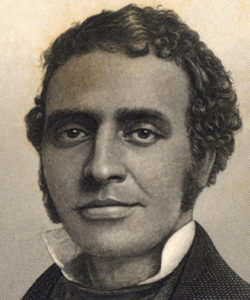
Charles L. Reason
*Charles L. Reason was born on this date in 1818. He was a Black mathematician, abolitionist, and teacher.
Charles Lewis Reason was from New York City. His parents, Michael and Elizabeth Reason, were immigrants from the West Indies. Early in his life, he attended the African Free School with his brothers Elmer and Patrick. He was an excellent student in mathematics and became an instructor at the school at the age of fourteen in 1832, receiving a salary of $25 per year. He used some money to hire tutors and later entered the ministry. Reason was rejected by the General Theological Seminary of the Protestant Episcopal Church in New York City for this career because of his race. He resigned in protest from St. Philip's Church (the congregation sponsored his application). He then studied at McGrawville College in McGraw, New York.
Reason helped draft a call to the first New York State Convention of Negroes in 1840 and advocated a manual-labor school to provide training in the industrial arts for Blacks. After this, he created a standard (teaching) school to answer the charge that Black teachers were inefficient and incompetent. His pursuit of a career in education was firmly rooted in his belief that it was the most effective means for Black advancement. Reason was also a writer. He contributed verse to the Colored American in the 1830s and led New York City's Phoenix Society in the 1840s. He wrote the poem "Freedom," which celebrated abolitionist Thomas Clarkson and was published in Alexander Crummell's 1849 biography of Clarkson.
Reason was also actively involved in politics throughout his life. He was committed to the cause of antislavery and the improvement of Black civil rights. In 1837, Reason, Henry Highland Garnet, and George Downing launched a petition drive supporting full Black suffrage. He was also secretary of the 1840 New York State Convention for Negro Suffrage. Reason was the founder and executive secretary of the New York Political Improvement Association, which won fugitive slaves the right to a jury trial. In 1841, he lobbied successfully for the abolition of the sojourner law, which permitted slave owners to visit the state briefly with their slaves. He also lectured on behalf of the Fugitive Aid Society.
In 1847, Reason and Charles B. Ray founded the “Society for the Promotion of Education among Colored Children,” a Black organization authorized by the state legislature to oversee Black schools in New York City. Reason also served as superintendent of P.S. 2 in 1848 and 1849. He became the first Black to hold a professorship at a predominantly white American college. This accomplishment occurred when he was hired as a professor of Greek, Latin, and French, as well as an adjunct mathematics professor, at New York Central College in McGrawville, New York.
In 1849, Reason, J. W. C. Pennington, and Frederick Douglass sponsored a mass demonstration against colonization at Shiloh Presbyterian Church in New York City. At the meeting, Reason quoted a former American Colonization Society agent in Africa, who claimed that the president and secretary of the society's colony of Liberia had business dealings with European slave traders on the African coast. In 1852, he became the first principal of Philadelphia's Institute for Colored Youth (now Cheyney University of PA), where he stayed until 1856. Reason returned to New York City for thirty-seven consecutive years as a teacher and administrator in the city's schools. In 1856, he was appointed Principal of School No.6 in New York.
He was an active reporter on education to the Black National Convention movement of the 1850s; he was secretary of their 1853 convention in Rochester, New York. He spoke out against the American Colonization Society and the African Civilization Society founded by Garnet.
During the American Civil War, Reason served on New York City's Citizens' Civil Rights Committee, which lobbied the New York legislature for expanded civil rights for Black Americans. After the war, he was vice president of the New York State Labor Union. In 1873, he headed the successful movement to outlaw segregation in New York schools. In 1882, teachers, superintendents, and principals of the New York City school system honored him for fifty years of service. In 1887, he became chairman of the Committee on Grammar School Work of the Teacher's Association.
Charles Reason was married and widowed three times; only the identity of his third wife, Clarice Esteve, is known. He died in New York City in 1893.
To become a High School Teacher
To Become a mathematician or statistician
Cheyney University archives have some of Reason's letters.
Anthony R. Mayo, "Charles Lewis Reason,"
Negro History Bulletin 5 (June 1942): 212-15.
C. Peter Ripley et al., eds.,
The Black Abolitionist Papers
(5 vols., 1985-1992)